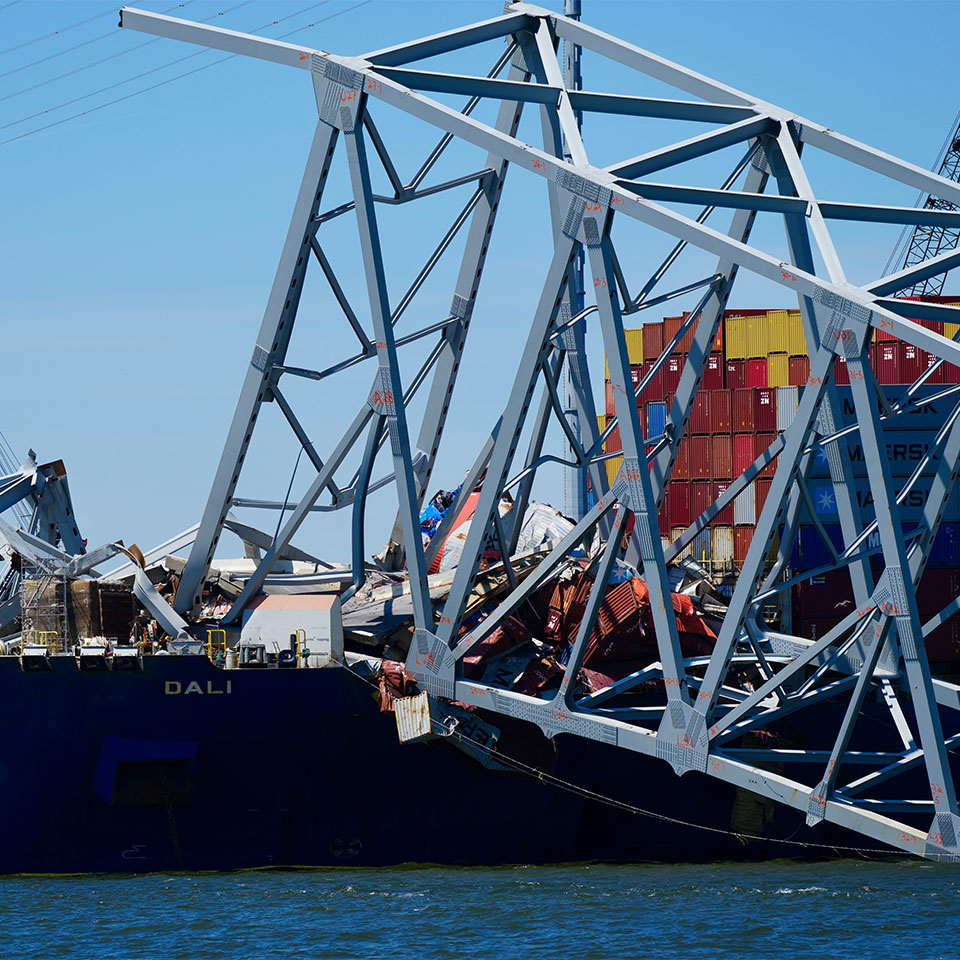

Extra Cover
Published in Extra Cover
The day the bridge fell
On 26 March 2024, the world wakes up to a tragedy of enormous proportions. The Dali container ship had just crashed into the pillars of the Francis Scott Key Bridge - the largest bridge in Baltimore in the USA – opened to traffic in 1977, causing most of it to collapse.
26 March 2024 will go down in history and become a regular mention in literature on insurance and risk management.
The world woke up in stark terror to images out of a Hollywood blockbuster that day. A massive freighter had rammed into one of the piers of the Francis Scott Bridge in Baltimore on the East Coast of the United States. The bridge collapsed instantly.
What people have termed one of the biggest claims in transportation insurance subsequent to the Costa Concordia capsizing is not, unlike what you may think, a highly unlikely event. Ships collide with bridges rather frequently. Not long ago, a similar even took place in Portugal involving the 25 April Bridge in Lisbon. However, this is the first event of such magnitude, with the most ramifications ever.
It also demonstrates the links among multiple risks or threats, such as the risk of a vessel colliding with a solid structure, an object colliding with a bridge, the risk of a bridge collapsing, risk of harbour blockage, disruption to supply chains, and so many more. So it’s never been more relevant to manage risk through a holistic approach rather than silo them, meaning we should not opt for a per-risk approach.
Beginning with the freighter itself, damage will be covered by a hull and machinery policy (H&M) while a policy of protection and indemnity (P&I) will cover liability to third parties arising from the collision.
A P&I policy is one of the most comprehensive types of coverage available, offering extensive safeguards. That owes to the fact that coverage is typically granted by “clubs” to their members, involving mutual and reciprocal interest.
Liability to third parties usually transferred to a P&I policy are as follows:
- Pollution: should fuel or other pollutants spill out, the policy will cover the effective leak or spill or the threat thereof, be it oil or another pollutant, as well as the costs of reasonable measures taken to prevent or mitigate pollution. The terms “effective” and “threat” are key here. The insured need not prove that pollution has occurred or would occur as a precondition for coverage.
- Shipwreck salvage: should the vessel suffer damage and be wrecked, the policy will pay for salvage, removal, destruction, lighting or signaling for the wreckage of the insured vessel. Liability for towing, if necessary, is likewise covered.
- Crew: P&I policies cover any crew-related liability with regard to injury or decease. Until now no reports have surfaced of incidents involving ship personnel.
- Damage to third parties: multiple vehicles and their occupants have fallen into the river and several deaths have been reported. The policy covers liability for injury, illness or death of non-crew persons, or ship passengers, owing to ship operations. Aid and rescue operations carried out are also covered.
- Freight: the policy likewise covers liability for loss of cargo, scarcity, damage, delays or other responsibilities related to cargo intended for transportation, en route on, or having been transported by the insured vessel, including the destruction of damaged cargo and non-removal of cargo by the consignee.
On this point, it is interesting to note that the owner of the vessel that destroyed the Francis Scott Key Bridge has initiated a formal process through which the companies that have shipped goods on this specific trip of the Dali will have to bear some of the financial loss, according to the largest container shipping company in the world.
A.P. Moller-Maersk A/S has reported that the process, termed “general average,” has been activated by Grace Ocean, a Singapore-based company, per notice to MSC Mediterranean Shipping Co., SA, on Friday.
- Fines and penalties: Any fines and penalties arising from the late delivery of cargo our accidental pollution (oil or any other pollutant) are covered as well.
- Damage to the road bridge: Fixed and Floating Objects (FFO) liability coverage included in the P&I policy can be activated. This coverage addresses compensation for any loss or damage to property on land or water during ship operations for the insured vessel.
Material damage to the bridge is equally safeguarded by a property policy and it is this policy which, regarding the specific case of the Baltimore bridge, will settle the first claims, although it is by itself insufficient to bear the full extent of compensation for the damage caused.
Meanwhile, obstruction of access to the Baltimore harbour is generating financial loss in the region of $15 million USD per day. We should expect multiple claims from companies related to loss of business arising from this event, whether through contingency coverage (lack of access) in their Loss of Business policies or supply chain policies.
This is, without a doubt, a milestone event for the insurance sector and society at large. The long-term consequences and ramifications are hard to estimate. It will take years to settle all the claims and countless court proceedings will arise.
